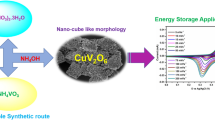Abstract
In the emerging field of electrochemical energy storage devices (EESDs), lithium (Li) ion-based EESDs are currently dominant. However, due to the high cost and lack of Li resources, researchers and industries look forward to replace Li with low-cost, safe, and highly abundant elements. Nowadays, immense research work on sodium (Na+), magnesium (Mg2+), and potassium (K+) ion–based EESDs are going on to replace Li-based EESDs. For any EESDs, the selection of a good electrolyte is a crucial task. The interaction of any ions with the electrode materials depends on the ionic radii, hydrated sphere size, conductivity, viscosity, and other parameters of selected electrolyte ions. In this manuscript, we explored the electrochemical behaviour of cationic species of various electrolytes (such as Na2SO4, MgSO4, K2SO4, and Li2SO4) with pseudocapacitive copper sulphide (CuS) electrodes. CuS is synthesized by a simple wet chemical route and characterized by various analytical techniques. Cyclic voltammetry and charge–discharge studies reveal that cations of each electrolyte are uniformly participating in the reduction and oxidation process. The rising trade of capacitance is observed with cations Li+ < K+ < Mg2+ < Na+. Pseuodocapacitive contribution profile of CuS with each electrolyte confirming that the charge storage mechanism of cations is mainly controlled by both diffusion and capacitive process. The electrochemical impedance spectroscopy profile of the examined electrolytes reveals that the Na+ ions show a low charge transfer resistance (2.497 Ω) as compared to others, which conclude that the Na+ ion–based electrolyte is an appropriate choice for the EESDs.










Similar content being viewed by others
References
Pal B, Yang S, Ramesh S (2019) Electrolyte selection for supercapacitive devices. Nanoscale Adv 1:3807–3835. https://doi.org/10.1039/c9na00374f
Vindt ST, Skou EM (2016) The buffer effect in neutral electrolyte supercapacitors. Appl Phys A Mater Sci Process 122:1–6. https://doi.org/10.1007/s00339-015-9563-8
Demir-Cakan R, Palacin MR, Croguennec L (2019) Rechargeable aqueous electrolyte batteries: from univalent to multivalent cation chemistry. J Mater Chem A 7:20519–20539. https://doi.org/10.1039/c9ta04735b
Kamath G, Cutler RW, Deshmukh SA et al (2014) In silico based rank-order determination and experiments on nonaqueous electrolytes for sodium ion battery applications. J Phys Chem C 118:13406–13416. https://doi.org/10.1021/jp502319p
Nakamoto K, Sakamoto R, Ito M et al (2017) Effect of concentrated electrolyte on aqueous sodium-ion battery with sodium manganese hexacyanoferrate cathode. Electrochemistry 85:179–185. https://doi.org/10.5796/electrochemistry.85.179
Li S, Qi L, Lu L, Wang H (2012) Facile preparation and performance of mesoporous manganese oxide for supercapacitors utilizing neutral aqueous electrolytes. RSC Adv 2:3298–3308. https://doi.org/10.1039/c2ra00991a
Fic K, Lota G, Meller M, Frackowiak E (2012) Novel insight into neutral medium as electrolyte for high-voltage supercapacitors. Energy Environ Sci 5:5842–5850. https://doi.org/10.1039/c1ee02262h
Wu H, Wang X, Jiang L et al (2013) The effects of electrolyte on the supercapacitive performance of activated calcium carbide-derived carbon. J Power Sources 226:202–209. https://doi.org/10.1016/j.jpowsour.2012.11.014
Feng J, Zhang Z, Li L et al (2015) Ether-based nonflammable electrolyte for room temperature sodium battery. J Power Sources 284:222–226. https://doi.org/10.1016/j.jpowsour.2015.03.038
Chung JS, Sohn HJ (2002) Electrochemical behaviors of CuS as a cathode material for lithium secondary batteries. J Power Sources 108:226–231. https://doi.org/10.1016/S0378-7753(02)00024-1
Goswami M, Nithya C, Sathish N et al (2020) Electrochemical studies on crystalline CuS as an electrode material for non-aqueous Na-ion capacitors. New J Chem 44:5278–5284. https://doi.org/10.1039/c9nj06465f
Saranya M, Santhosh C, Ramachandran R et al (2014) Hydrothermal growth of CuS nanostructures and its photocatalytic properties. Powder Technol 252:25–32. https://doi.org/10.1016/j.powtec.2013.10.031
Li J, Yan D, Lu T et al (2017) Significantly improved sodium-ion storage performance of cus nanosheets anchored into reduced graphene oxide with ether-based electrolyte. ACS Appl Mater Interfaces 9:2309–2316. https://doi.org/10.1021/acsami.6b12529
Jin X, Li J, Chen G et al (2016) Preparation of Cu2ZnSnS4-based thin film solar cells by a combustion method. Sol Energy Mater Sol Cells 146:16–24. https://doi.org/10.1016/j.solmat.2015.11.0270927-0248
Zhu J, Xu Y, Wang J et al (2015) The effect of various electrolyte cations on electrochemical performance of polypyrrole/RGO based supercapacitors. Phys Chem Chem Phys 17:28666–28673. https://doi.org/10.1039/c5cp04080a
Zhong C, Deng Y, Hu W et al (2015) A review of electrolyte materials and compositions for electrochemical supercapacitors. Chem Soc Rev 44:7484–7539. https://doi.org/10.1039/c5cs00303b
Nitta N, Wu F, Lee JT, Yushin G (2015) Li-ion battery materials: present and future. Mater Today 18:252–264. https://doi.org/10.1016/j.mattod.2014.10.040
Li Y, Zhang W, Dou Q et al (2019) Li7La3Zr2O12 ceramic nanofiber-incorporated composite polymer electrolytes for lithium metal batteries. J Mater Chem A 7:3391–3398. https://doi.org/10.1039/c8ta11449h
Acknowledgements
Author thanks Director CSIR-AMPRI, Bhopal for extending the lab facilities. We are very thankful to MRC, MNIT, Jaipur for the characterisation facility. The author acknowledges SERB, New Delhi (File no; EEQ/2018/000068) for financial support.
Author information
Authors and Affiliations
Corresponding author
Ethics declarations
Conflict of interest
We declare there is no conflict of interest.
Additional information
Publisher's note
Springer Nature remains neutral with regard to jurisdictional claims in published maps and institutional affiliations.
Supplementary Information
Below is the link to the electronic supplementary material.
Rights and permissions
About this article
Cite this article
Goswami, M., Kumar, S., Singh, N. et al. Effect of electrolyte cations on electrochemical performance of pseudocapacitive CuS electrode. Ionics 27, 5277–5285 (2021). https://doi.org/10.1007/s11581-021-04241-4
Received:
Revised:
Accepted:
Published:
Issue Date:
DOI: https://doi.org/10.1007/s11581-021-04241-4




